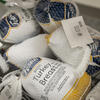
According to Joshua Mask of the Economics Department in the College of Liberal Arts, Philadelphians will have to pay more for their turkeys than the rest of the country this year.
Photo by Betsy Manning
It was just last month that it was reported that inflation had reached its highest level since this past January. This also comes right before the Thanksgiving holiday, which is celebrated by more than 90% of Americans.
In just a few days, folks across the country will settle in for a meal that is sure to leave a strong impression on their stomachs. It might have a similar effect on their wallets.
Joshua Mask is an assistant professor of instruction in the Economics Department at Temple University’s College of Liberal Arts. His research focuses on the business cycle and how it affects wages and opportunities in the long run.
Temple Now caught up with Mask ahead of the holiday to gain his insights into what Americans—and Philadelphians—should expect to pay this year for their Thanksgiving dinner.
Temple Now: So, with Thanksgiving on the horizon, how are things looking this year from a cost standpoint? Will a traditional holiday feast be any easier on the wallet?
Joshua Mask: So, interestingly, on the national level, we are seeing a slight decrease from last year in terms of costs. We are seeing a drop of about 5% from 2024. As you may recall, there was a record high in 2022, and it's been slightly dropping ever since. However, in Philadelphia, we are seeing a significant rise of 18.5% in the price of a thanksgiving meal that feeds 10 people.
Now, there could be a variety of factors for that. For one, regional inflation can be different than national inflation. There is also a distribution problem. If you’re in the suburbs, suppliers just drop off everything at a big box store, which serves the whole area. That’s a very easy delivery, and logistics are cheap. But here in Philadelphia, you are trying to deliver to these small stores, and that store represents the last mile of delivery. That's always the most expensive piece of this. Philadelphians also already sort of face a higher standard of living than the rest of the country just because of where we are, so that is being factored into Thanksgiving prices as well.
TN: That is a significant difference between the national costs going down 5% as opposed to costs going up nearly 20% here. Why is that?
Mask: Particularly, food inflation in an urban center like Philadelphia is different from what it is across the rest of the country. Logistics and market concentration are going to be uniquely stronger here than in other areas. When you're talking about the country at large, you're talking about city, suburban, urban, and rural areas, so the dynamics are going to be much different across the country than they are for a big, major urban center like Philadelphia. Digging into the results a bit, I can see that turkey prices drive a lot of this divergence. Turkey prices are going up significantly in Philadelphia but falling nationally. Local market factors — including supply disruptions from recent avian flu outbreaks in the region — could contribute to that difference.
TN: As we move past Thanksgiving and into some of the other holidays, do you expect this trend to continue, where food costs continue to rise at a higher rate here in Philadelphia as opposed to other areas?
Mask: My guess is yes. If you're seeing a trend increase for Philadelphia going into Thanksgiving, then you will probably see that going into Christmas, as well. Now, the prices aren't going to go up or down dramatically between Thanksgiving and Christmas, but they will be higher here in Philadelphia than in other parts of the country. Like I said, this is really part of a longer-term trend specific to this region, where food inflation has been going up steadily in this region for some time. But those turkey prices are hitting Philadelphians especially hard this year.
TN: I know it is too early to speculate, but with turkey prices going up nearly 20% this year, is this something we should expect next year? And in years after that?
Mask: Well, I wouldn’t rule it out. The logistic factors unique to Philadelphia and the avian flu aren’t going away anytime soon. But when you talk about food inflation in a region, you must compare that to wage inflation in that area. So, what does wage inflation look like nationally? What does wage inflation look like for Philadelphia? It's going to be larger here as wages grow faster in urban centers. So, if wage inflation is keeping up with grocery inflation, then people don't really feel it, and they're not going to notice that. The concern is that food inflation is starting to go up at a faster rate than wages are. So, that would be the metric that I would be comparing it against.
READ MORE
Liberal arts at Temple: Prepare for the ever-changing global landscape, where advances in technology and social dynamics occur every day, with an education for the College of Liberal Arts.
Economics at Temple: Understand social behavior and business conduct from an economist’s perspective with the bachelor of arts in economics in the College of Liberal Arts at Temple University. This 123-credit undergraduate degree program helps you think critically and logically about the economy.
Become an Owl: Learn more about applying for one of our undergraduate, graduate or professional programs.

Photo by Contributed photo
Josh Mask
Assistant Professor - Instructional
Dr. Joshua Mask is an Assistant Professor of Instruction in the Economics department at Temple University.
Read More